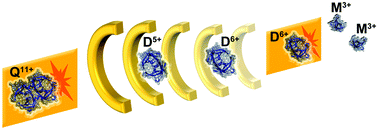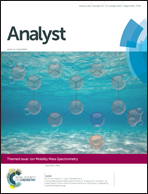Illustration of SID-IM-SID (surface-induced dissociation-ion mobility-SID) mass spectrometry: homo and hetero model protein complexes†
Abstract
The direct determination of the overall topology and inter-subunit contacts of protein complexes plays an integral role in understanding how different subunits assemble into biologically relevant multisubunit complexes. Mass spectrometry has emerged as a useful structural biological tool because of its sensitivity, high tolerance for heterogeneous mixtures and the fact that crystals are not required. Perturbation of subunit interfaces in solution followed by gas-phase detection using mass spectrometry is a current means of probing the disassembly and hence assembly of protein complexes. Herein, we present an alternative method that employs native mass spectrometry coupled with ion mobility and two stages of surface induced dissociation (SID) where protein complexes are dissociated into subcomplexes in the first SID stage. The subcomplexes are then separated by ion mobility and subsequently fragmented into their individual monomers in the second SID stage (SID-IM-SID), providing information on how individual subunits assemble into protein complexes with different native topologies. The results also illustrate complex dependent differences in charge redistribution onto individual monomers obtained in SID-IM-SID.

- This article is part of the themed collection: Ion Mobility Mass Spectrometry

 Please wait while we load your content...
Please wait while we load your content...